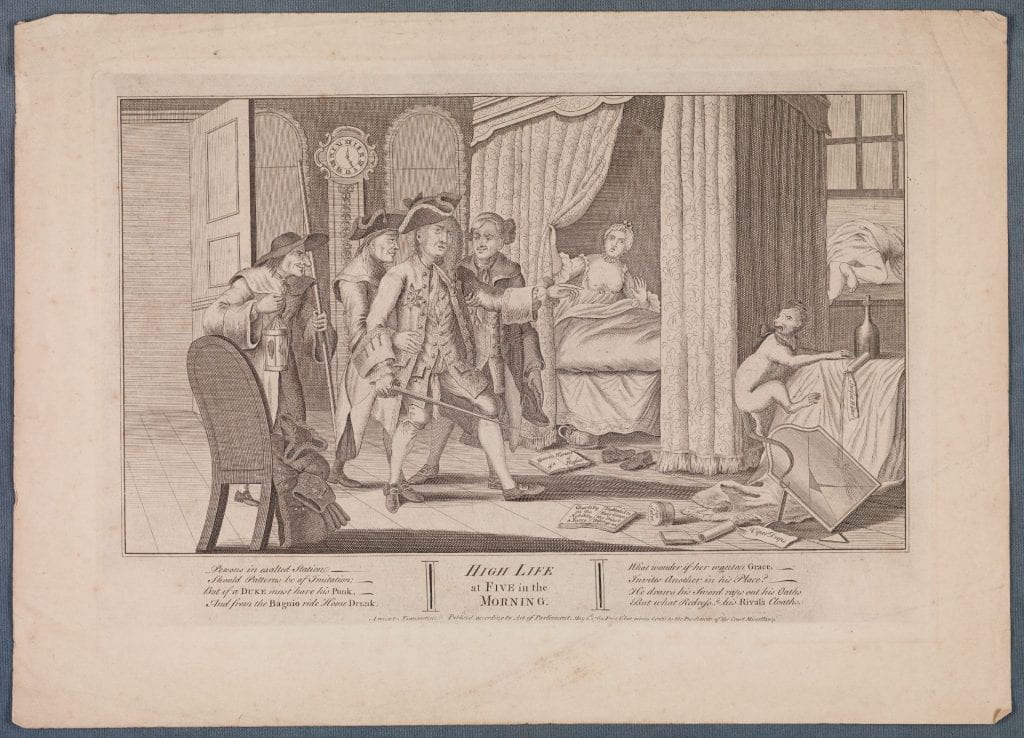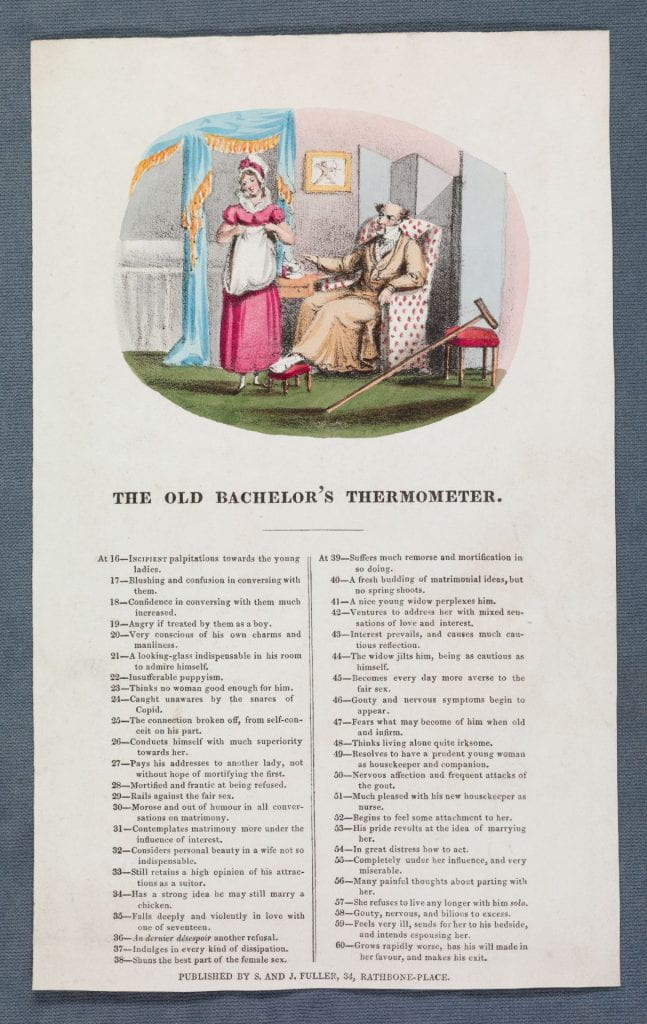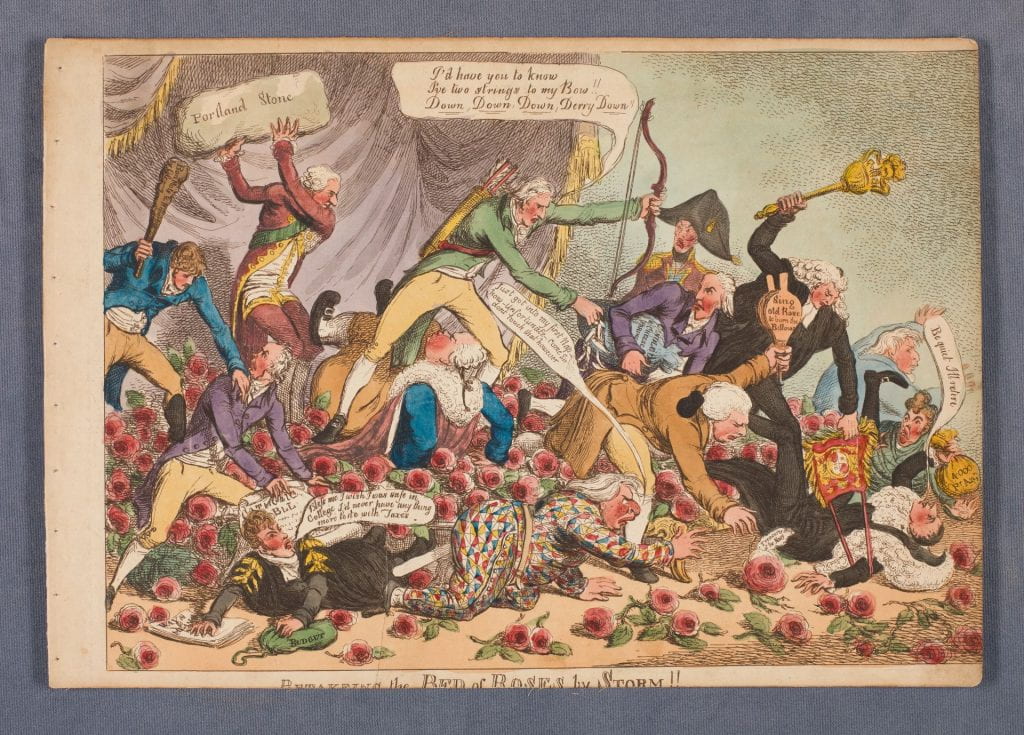
“A burlesque coronation of the Queen. She sits enthroned on a dais, raising her right foot with tipsy joviality. In her right hand as sceptre is a rod topped by a tiny cask which a naked Bacchus bestrides. The orb in her left hand is a decanter; on her head is a tilting punch-bowl. She watches her champion Wood (left) (acting the part of Dymoke, cf. British Museum Satires No. 14193), a grotesque figure in armour on a caparisoned ass (see British Museum Satires No. 14146). He has just thrown down the glove, pulling his braying mount on to its haunches, and looks up with a fatuous stare at the Queen. His helmet is topped by an owl from which clouds of smoke ascend (cf. British Museum Satires No. 14196). John Bull (right), a ‘cit’ wearing an ill-fitting wig and top-boots, stoops to pick up the glove, supporting himself by a cudgel inscribed My God My King a[nd my] Country. Between these two foreground figures stands a ragged newsboy holding his horn, the paper in his cap inscribed Brandy burgh [cf. British Museum Satires No. 14191] Gazette; slung from his shoulders is a large sheaf of his newspaper, Brandyburg Gazette Extraordinary–Baron B…..i to be Il Baron par Excellence–Ad- W – – d to be Earl Log [see British Museum Satires No. 14189]–Lady A H [Anne Hamilton] to be Spinster for Life–L. H – – d to be Marquis Doodle. Attendants are grouped round the Queen on the dais, which is under festooned curtains. These are (left to right): Denman and Brougham, in wig and gown, applauding and gesturing; two turbaned Turks; Bergami, handsome and complacent, at the Queen’s right hand. Slightly behind are a simian face, Lady Anne Hamilton wearing the feathered Scots cap of British Museum Satires No. 14175, and another woman, Italian in appearance (probably Countess Oldi). Behind the Queen’s chair on the right are two hooded figures, the more prominent, who holds a decanter, being Viscount Hood, the other perhaps Keppel Craven. Two naval officers must be Hownam and Flinn. On the canopy of the throne behind the Queen are her arms; the quarterings are wine-glasses, bottles, a tent (see British Museum Satires No. 13818), and a bath containing a tiny figure (see British Museum Satires No. 13819). The supporters are a satyr and a goat; the motto, Bergami and My Bottle [see British Museum Satires No. 14175]. On the extreme left, supported on Gothic arches, is a gallery crowded with ladies, as in Westminster Abbey at the Coronation. On a lower level, seen through the arches of the Abbey, is a dense proletarian crowd with banners, pikes, and caps of Liberty. The characters are indicated by inscriptions divided by vertical lines, as in British Museum Satires No. 14182, and centred by a cartouche. These are (left to right): Mobility in Attendance. The Champion of Absolute Wisdom [see British Museum Satires No. 13899] on his renowned Steed. The Keepers of her Majesty’s Conscience [her Counsel]. Her Majesty’s Lord Great Chamberlain Her Majesty’s Privy Counsellor Knight Commander of the Bath Chief Performer of the Canopy Service and Courier Extraordinary [Bergami]. Hooded Doodles in Waiting [Lord Hood and his companion]. Barons of the Bedposts. Performers of the Canopy Service [the naval officers]. In the cartouche: If any Person of what degree soever, high or low, shall deny or gainsay our Puppet C . r . l . . e Columbina [see British Museum Satires No. 14120] of Brandy-burgh House, of the United Kingdoms of Soberness and Chastity, Defender of the easy Virtues &c &c the Right of being Crowned with a crown Bowl of Imperial Punch, or that she should not enjoy the same, here is her Champion, who saith he doth not care a Drug, being ready in person to lay a bet that she is, and in this wager will venture his Eighteen Pence against a Shilling wherever, and whenever his Adversary may choose.”–British Museum online catalogue.
- Printmaker: Lane, Theodore, 1800-1828, printmaker.
- Title: The grand coronation of Her Most Graceless Majesty C-r-l–e Columbina, the first queen of all the radicals &c &c &c, July 19th, 1821 [graphic].
- Publication: London : Pubd. by G. Humphrey, 27 St. James’s Street, August 6th, 1821.
Catalog Record
821.08.06.01+
Acquired March 2020






 “A low platform covered with roses extends almost across the design; from this bed new Ministers advancing from the left are ejecting the old. Roses are scattered on the floor. The central figure is the tall and handsome Castlereagh, author of the phrase, see British Museum satires No. 10558, &c. With a taut two-stringed bow in his left hand, a quiver on his shoulders, he strides across Grenville who is on his back on the bed, and takes ‘Candle End[s] & Cheese Paring[s]’ from a bag with which Windham tries to make off (see British Museum Satires No. 9735). He says: “I’d have you to know I’ve two strings to my Bow!! Down, Down, Down, Derry Down!!” [See British Museum satires No. 10426.] Behind him, Portland threatens Grenville (in his peer’s robe) with a big block of ‘Portland Stone’ [see British Museum Satires No. 10718, &c.]. In front of Windham Rose steps forward from the bed to grasp a large rose on the floor: ‘Treasurership of the Navy.’ This Sheridan, in his Harlequin’s suit (see British Museum Satires No. 9916), is crawling towards, saying, “Just got into my first Nap – how – Unfortunate – come Sir fat touch that however.” Rose holds up a pair of bellows inscribed ‘Sing old Rose & burn the Bellows’. Eldon, in Chancellor’s wig and gown, strides from the bed on to the prostrate Erskine, seizing the Purse of the Great Seal, whose cord is still round the latter’s arm. He raises the mace to strike the ex-Chancellor, whose wig has fallen off. Erskine says: “Be quiet I’ll retire”; he holds a money-bag inscribed ‘4,000 Pr Anm’ [see British Museum Satires No. 10714]. Lauderdale, wearing a plaid, is behind him on the ground. On the extreme left Canning, standing on the bed, holds up a massive club inscribed ‘Bon Mots & Repartee by G C–g’; he stoops over Howick pointing at the ‘Catholic Bill’, which the latter holds. Howick steps from the bed, angrily looking up at Canning (his especial enemy, cf. British Museum Satires No. 10972), but, unlike his colleagues, not devoid of dignity. On the ground between Howick and Sheridan is Petty in his gown, one hand on his ‘Budget’, a small bag, the other on a sheaf of papers inscribed ‘Ways & Means’. He says: “Bless me I wish I was safe in College I’d never have anything more to do with Taxes” [an allusion to his youth, and to the fact that he was M.P. for Cambridge]. In the background (right) are Moira in his cocked hat and Lord Temple who makes off rapidly.”–British Museum online catalogue.
“A low platform covered with roses extends almost across the design; from this bed new Ministers advancing from the left are ejecting the old. Roses are scattered on the floor. The central figure is the tall and handsome Castlereagh, author of the phrase, see British Museum satires No. 10558, &c. With a taut two-stringed bow in his left hand, a quiver on his shoulders, he strides across Grenville who is on his back on the bed, and takes ‘Candle End[s] & Cheese Paring[s]’ from a bag with which Windham tries to make off (see British Museum Satires No. 9735). He says: “I’d have you to know I’ve two strings to my Bow!! Down, Down, Down, Derry Down!!” [See British Museum satires No. 10426.] Behind him, Portland threatens Grenville (in his peer’s robe) with a big block of ‘Portland Stone’ [see British Museum Satires No. 10718, &c.]. In front of Windham Rose steps forward from the bed to grasp a large rose on the floor: ‘Treasurership of the Navy.’ This Sheridan, in his Harlequin’s suit (see British Museum Satires No. 9916), is crawling towards, saying, “Just got into my first Nap – how – Unfortunate – come Sir fat touch that however.” Rose holds up a pair of bellows inscribed ‘Sing old Rose & burn the Bellows’. Eldon, in Chancellor’s wig and gown, strides from the bed on to the prostrate Erskine, seizing the Purse of the Great Seal, whose cord is still round the latter’s arm. He raises the mace to strike the ex-Chancellor, whose wig has fallen off. Erskine says: “Be quiet I’ll retire”; he holds a money-bag inscribed ‘4,000 Pr Anm’ [see British Museum Satires No. 10714]. Lauderdale, wearing a plaid, is behind him on the ground. On the extreme left Canning, standing on the bed, holds up a massive club inscribed ‘Bon Mots & Repartee by G C–g’; he stoops over Howick pointing at the ‘Catholic Bill’, which the latter holds. Howick steps from the bed, angrily looking up at Canning (his especial enemy, cf. British Museum Satires No. 10972), but, unlike his colleagues, not devoid of dignity. On the ground between Howick and Sheridan is Petty in his gown, one hand on his ‘Budget’, a small bag, the other on a sheaf of papers inscribed ‘Ways & Means’. He says: “Bless me I wish I was safe in College I’d never have anything more to do with Taxes” [an allusion to his youth, and to the fact that he was M.P. for Cambridge]. In the background (right) are Moira in his cocked hat and Lord Temple who makes off rapidly.”–British Museum online catalogue. “Ministers recline on a large low platform, representing a magnificent state bed, which is completely covered with roses. It recedes in perspective from left to right. On the left is Fox, looking sourly over his left shoulder at his neighbour, Sheridan, to say: “This is the most uncomfortable bed I was ever on in my Life and not the least like a bed of Roses – Zound!! what a thorn is running into me – Oh that Bramble – Sherry my Dear how do you find it – “. Sheridan answers: “My dear Charley, I have not had a wink since I have been on it, – curse that Castle man what did he mean by his bed of roses – I am as sore from the tip of my Nose, to the tip of my Toe – as if I had been roling on a quick set-hedge – or stung to death by a swarm of bees at a Hampshire Farmers [an allusion to Cobbett’s pen]”. Behind Fox, and in profile to the left, Moira, in uniform, with cocked hat and jack-boots, sits up, very erect; he says: “What are Cannons or Bombs or clashing of swords, compared to the pain I endure.” Windham, next Sheridan, registering melancholy, says: “I feel more uneasy than if the whole Volunteer force was upon me.” Ellenborough, behind Sheridan and Windham, ill-temperedly puts his hand to his wig. Erskine, also in wig and gown, reclines as if exhausted, his eyes closed, his attitude characteristic of his notorious fainting in court (see British Museum Satires No. 7956). He and Grey (Lord Howick from 11 Apr.), who sits behind him, are in profile to the right; the latter says: “It is just such a bed, as I expected the late bungling bed makers would leave us.” On the extreme right little Lord Henry Petty (wearing his Chancellor of the Exchequer’s gown) sits up, angrily holding above his head two handfuls of thorn-branches. He says: “I shall never have done clearing the brambles and Nettles from this Bed, my Budget would not hold one half of them.” The low frame of the bed is carved and has a valance of fringed and festooned draperies. At the head are the Royal Arms; looped curtains are suspended above it.”–British Museum online catalogue.
“Ministers recline on a large low platform, representing a magnificent state bed, which is completely covered with roses. It recedes in perspective from left to right. On the left is Fox, looking sourly over his left shoulder at his neighbour, Sheridan, to say: “This is the most uncomfortable bed I was ever on in my Life and not the least like a bed of Roses – Zound!! what a thorn is running into me – Oh that Bramble – Sherry my Dear how do you find it – “. Sheridan answers: “My dear Charley, I have not had a wink since I have been on it, – curse that Castle man what did he mean by his bed of roses – I am as sore from the tip of my Nose, to the tip of my Toe – as if I had been roling on a quick set-hedge – or stung to death by a swarm of bees at a Hampshire Farmers [an allusion to Cobbett’s pen]”. Behind Fox, and in profile to the left, Moira, in uniform, with cocked hat and jack-boots, sits up, very erect; he says: “What are Cannons or Bombs or clashing of swords, compared to the pain I endure.” Windham, next Sheridan, registering melancholy, says: “I feel more uneasy than if the whole Volunteer force was upon me.” Ellenborough, behind Sheridan and Windham, ill-temperedly puts his hand to his wig. Erskine, also in wig and gown, reclines as if exhausted, his eyes closed, his attitude characteristic of his notorious fainting in court (see British Museum Satires No. 7956). He and Grey (Lord Howick from 11 Apr.), who sits behind him, are in profile to the right; the latter says: “It is just such a bed, as I expected the late bungling bed makers would leave us.” On the extreme right little Lord Henry Petty (wearing his Chancellor of the Exchequer’s gown) sits up, angrily holding above his head two handfuls of thorn-branches. He says: “I shall never have done clearing the brambles and Nettles from this Bed, my Budget would not hold one half of them.” The low frame of the bed is carved and has a valance of fringed and festooned draperies. At the head are the Royal Arms; looped curtains are suspended above it.”–British Museum online catalogue.